5 Minutes with... Chris Bruntlett, Dutch Cycling Embassy
Ahead of Intertraffic Amsterdam 2024, we sat down with renowned mobility expert, Chris Bruntlett of the Dutch Cycling Embassy. Delve into his insights on urban mobility shifts, prioritising active travel for children, sustainability, and beyond!
Intertraffic: In the last five years, what one new innovation or one new development has made your job easier? It can be new technology, new thinking, new legislation… what would it be? And why?
Chris Bruntlett (CB): Without exaggeration, the COVID-19 pandemic changed everything about how cities think about their mobility networks and their impact on the allocation of public space. Virtually overnight, governments were scrambling to create pop-up bike infrastructure and outdoor dining districts, with a sudden appreciation for the fragile and inefficient nature of a one-sided, car-based transportation system. At the same time, the removal of motor traffic afforded citizens the opportunity to experience and utilize their streets in new and exciting ways, whetting a newfound appetite for more safe, sustainable, and active ways to travel around the city. In a few years’ time, we will likely look back on this period as the start of a new “bike boom” in cities around the world.
Intertraffic: Which trend or topic do you think is going to be the number one conversation starter in 2024? This year for example was undoubtedly the proliferation of artificial intelligence in smart mobility solutions.
CB: The future of cities belongs to its children, and enabling safe and active travel to school has become an unstoppable global movement. We’ve seen the rise of the “bike bus” that allows kids to cycle safely together in a scheduled, structured, and supervised format. And “school streets” temporarily closes down spaces outside of schools to motor vehicles, opening opportunities for students to get outside, move their bodies and meet their friends. These light, quick, cheap initiatives have been immensely popular—in their neighbourhoods and on social media—offering a new way to get communities thinking about their priorities and aspirations.
Intertraffic: If you could change one thing about the sector you work in that will be of benefit to society as a whole, what would that be?
CB: When it comes to accelerating the sustainable mobility transition, the transportation sector’s time, energy, and money remains almost entirely focused on electrifying the existing car-based system. This unfortunately ignores the myriad other challenges created by car dependence—including traffic, safety, and cost—as well as the tremendous potential to shift many trips to a combination of walking, cycling, and public transport. Relatively modest, targeted investments in alternatives to the private automobile could have a swift and significant impact on travel behaviour, while having the added benefit of creating a healthier and happier population, a low-congestion and low-maintenance road network, and a public realm where people want to spend time and money.
Intertraffic: What subject did you study at University and has it actually helped you during your career in the smart mobility/ITS world?
CB: I studied architecture in university, and worked for many years in the industry, before a more recent transition into the world of active and sustainable mobility. I like to describe this transition as beginning my career with a fascination in buildings, before gradually realizing I was far more interested in the space between them. By experiencing the joy (and challenges) of raising a young family in Vancouver without a car, I gained a first-hand appreciation for how the space between buildings—and the way it is used and allocated—deeply impacts our quality of life. A 2016 holiday to the “bicycle paradise” of the Netherlands was nothing short of life-changing, inspiring a book and career change into the field.
Intertraffic: Away from the business world, what would constitute a perfect Saturday for you?
CB: After an intense work week of endlessly talking about cycling, I enjoy actually doing a bit of it on the weekends, opting to explore my adopted country on two wheels. There is nothing I enjoy more than taking a train to a remote corner of the Netherlands, renting a blue-and-yellow shared bicycle, and losing myself amongst the polders, forests, and sand dunes. I also enjoy documenting these adventures on social media, using a still and video camera mounted to my handlebars, sharing the joy of living in a environment where cycling isn’t just possible… it’s delightful.
CB: With my public-facing position and persona, I am lucky enough to receive near-daily requests from people and organizations looking for advice—either with their career or efforts in making their city more cycle-friendly. I pride myself in taking the time to respond to every one of these requests (within reason) and offer them the support and resources needed at that moment in time. I recognize I wouldn’t be in the privileged position I am now without others generously giving me their time, so I make a point of “paying it forward” and doing what I can to help.


